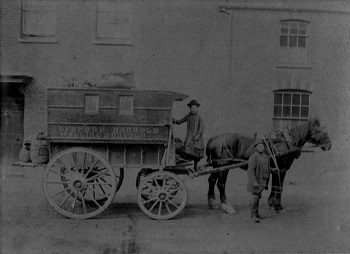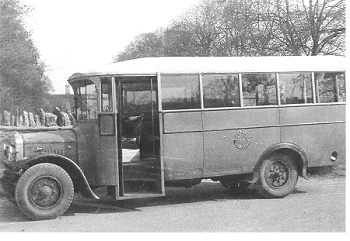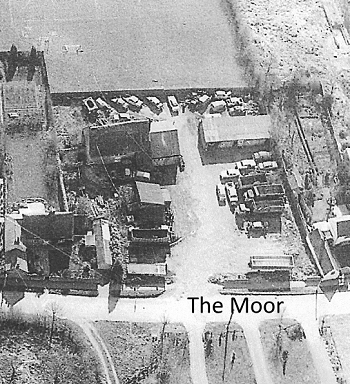Carriers Way
This page was written by Pamela Hider
The historian, the late Alan Everitt, wrote of the importance of the village carriers of England in the 19th century, usually villagers themselves operating on a humble scale. They not only transported goods and parcels to and from nearby towns, they were often the only form of public conveyance, taking villagers to the nearest market town, motorbuses not reaching rural areas until the 1920s. Carriers also conveyed dairy and farm produce to towns to be sold. Alan reminded us that in their own small way, Carriers were serving a very useful purpose, linking the villages to the towns, supporting village industries, and recognising that the railway, far from killing off their livelihood, made them more necessary than ever. They were opening up new horizons and were not to be underestimated.
19th Century
The earliest name most closely associated with Carriers in Carlton, and which endured for almost 200 years, was Franklin. They were all closely related and were all descendants of John and Hannah Franklin (née Pettit) married on May 24th 1802 at Chellington (Chellington Parish Registers Vol.52).
Pigot's directory for Bedfordshire, dated 1830, lists a Thomas Johnson as Carrier from Bedford to Harrold (presumably going through Carlton). Subsequent directories (Pigot's 1839, Slaters 1850, Post office 1854) mention Johnson and Franklin as Carriers, to Bedford and Wellingborough. It is possible that the Franklins had some involvement with the Johnsons in the early 1830s, as the Franklins were to celebrate their 'centenary' in 1931 (see below) although no records are found with their name until 1839. After 1854, Johnsons are no longer mentioned in trade directories, but the Franklin name endures and is mentioned exclusively, thereafter, in trade directories as Carriers through Carlton.
At the time of enclosure (1806), the built up areas in Carlton were in today's Bridgend and the High Street. The land in-between was mainly farmland reaching from today's Moor to the Causeway and extending beyond on either side. Only occasional farm buildings were in evidence along the Moor, including a smallholding, close to Bridgend on the site now known as Carriers Way. Charles was the Franklin mentioned in Pigot's directory of 1839 and the Post Office directory of 1854 and electoral rolls show him to be living at Bridgend from 1851 until 1870, after which he moved further along to where Bridgend becomes Pavenham Road. Charles died, a widower, in 1889 aged 87.
William Franklin
In the 1861 census, William was living in the High Street with his wife and family and was described as 'Higler and Carrier' (a higler was an itinerant trader). William is listed in the 1864 Post Office directory for Carlton as 'Carrier to Bedford'.
Robert Franklin
In the 1871 census, William's son, Robert, 'Carrier', was now living at Bridgend with his family. By 1881 he was 'Carrier employing 1 man and 2 boys'. By 1891 he was 'Carrier' again, and the occupations of two of his children were described as 'Carrier's Assistant'. At that time, transportation would have been by horse-drawn wagon and tradition has it that the horses were stabled at the smallholding mentioned above.

Robert Franklin next to horse & daughter Mercy on wagon, c.1890s
20th Century
Robert's wife, Louisa, and mother of all his children, had died in 1886 aged 41. By the 1901 census, Robert was living with his second wife in Peartree Cottage in today's Causeway. He was described as 'Carrier and Carter'. This cottage was directly behind the land which was behind the smallholding. One of his married sons was described as 'Parcel Carrier' in the same census, so was probably working for his father. Robert died in 1920, outlived by his second wife, who survived him by 11 years. Kelly's directory of 1924 gave the name Alfred Franklin as Carrier.
Rating and Valuation Act 1925
This Act specified that every building and piece of land in the country was to be assessed to determine its rateable value. This was done in Carlton in 1927 (DV1/C218). Its findings proved to be very informative indeed, as it revealed that the smallholding, the properties close to it, the land behind it and the cottages behind that (in today's Causeway) were all owned by Mrs.R.Franklin (Robert's widow). This suggests that perhaps the land had also been owned by the Franklins during the 19th century.
The smallholding was described as "stone & thatch farm, barns & premises on The Moor" consisting of: "stable for 2 & open bay, meal house, stable for 1 & hovel, barn (large), pig sties, cart shed. Wood & C.I. Cart shed, lean to fowl house, pig sty. All standing in good yard. Has only a little land, is a Carrier as well". The occupier was A.Jarvis. Albert Jarvis had married Robert's daughter, Eva, in 1919. Albert & Eva lived in the farmhouse next to the farm (today's no.7 The Moor). At that time, the farmhouse was semi-detached to another cottage, in which another of Robert's daughters, Mary, lived, now a widow, having lost her husband in the war. Her two sons were drivers for the business in the 1920s. These two cottages became one and is known as Bumble Cottage, which will be dealt with on another page.
Buses
In 1921 the service had become motorized with the purchase of a green Ford lorry, and buses were now the coming thing. Although passengers had been carried, it was the delivery service which was most remembered in the village when people didn't travel so much, but now that passengers were able to be carried, this put a new perspective on the service. By 1927, the business had passed to Albert Jarvis and when a company called Dreadnought started operating a bus service from Harrold to Bedford via Carlton & Oakley, Albert took it over and merged it with his own. In 1931, a new Thorneycroft bus was acquired to mark the centenary of the Franklin's Carrier trade in Carlton. It was known as the Century bus.
 Century Bus
Century Bus
Eventually,the carrier service began to wind down as buses took priority. A second bus was acquired and both buses were housed in a garage at the smallholding, next to the old stables. Our record DV1/X68 (1930-31) records the addition of a large double garage of corrugated iron construction and with a concrete floor with pit. Albert continued to be named as Carrier in Kelly's directories of 1928, 1931 & 1940. He died in 1943, when his widow, Eva, continued to run the service and a third bus was acquired. In 1949, ill health forced Eva to sell the business to Birch Brothers of Rushden. Eva died in 1954. She and Albert are buried in Carlton churchyard.
Final Days
The freight side of the business now dealt with Biddenham Dairies in Bedford and another dairy in Huntingdonshire. It had been taken over by K&B Ward Ltd. Haulage Contractors, who later diversified into carrying coal. Ken Ward retired in the early 1970s when the site was then sold and put up for housing development. The site had always been known as either Franklins' Yard, Carriers' Yard, or Ward's Yard (although it appeared on a 1970 OS map as Rockingham Farm). The Parish Council chose the name Carriers Way for the road to be built through the site.

Site clearance of Ward's Yard, 1973

Carriers Way, 2023. The lime clad building is the large barn mentioned in the 1927 description of the farm above.
Black & white photos courtesy of Carlton & Chellington Historical Society.
Other sources:
Z1521/1/8/3: Carlton & Chellington Historical Society newsletter Volume 8 No 3, September 2010